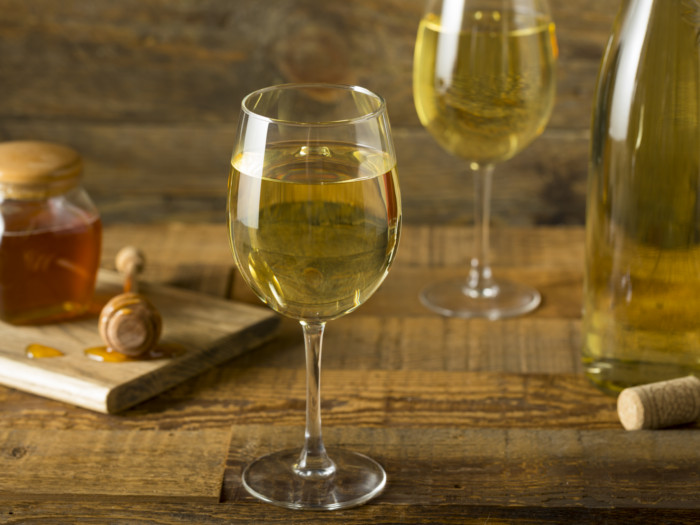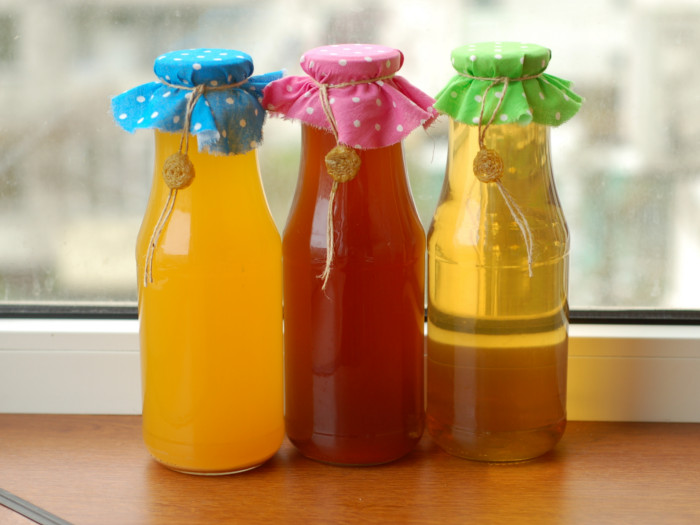Mead, an ancient drink of fermented honey and thought by many to be one of the first fermented drinks, is enjoying a resurgence in popularity. The modern variety of this beverage has been embraced by craft brewers, who now churn out a wide variety of flavors from very dry to sweet.
What is Mead?
Mead is made by fermenting honey with water and often adding other fruits or spices. It has been consumed all over the world for centuries. Flavors can vary wildly based on the fruit or flavors used, but a true one will be sweet and strong, with ABV ranging anywhere from 4% to 20%. [1]

Mead is made by fermenting honey with water, sometimes with fruits, spices, grains, or hops. Photo Credit: Shutterstock
Types
There are over 30 different styles of mead from around the world. Here is the list of the most common types. [2]
- Acerglyn: It is a sweet type made with honey and maple syrup
- Bilbernel: It is a variety made with either blueberry juice or blueberries
- Black: It is brewed with black currants
- Bochet: A version where the honey has been caramelized or burnt before brewing
- Braggot: A mead that is brewed with a malt and sometimes hops
- Capsicumel: A type flavored with either mild or hot peppers
- Dandaghare: A drink produced in Nepal that is flavored with traditional Himalayan spices
- Hydromel: A low-alcohol variety with a lighter taste
- Medica: A Slovakian style of this alcoholic beverage
- Morat: A popular type brewed with mulberries
- Omphacomel: It is brewed with the juice of unripe grapes or apples
- Rhodomel: It is brewed with either rose petals, rose hips or rose attar
- Show Mead: A “plain” style, made only with honey, water, and sometimes a yeast additive
- Sima: A lemon-flavored variety from Finland
Food Pairings
Pair dry ones with cheese, or complement more fruit-heavy meads with spicy flavors. Fruity meads go well with fruit-based desserts while the floral and citrus varieties pair beautifully with salads.
How to Make Mead At Home?
There are a few steps involved in the preparation of mead, these include the following.

Homemade Mead Recipe
Ingredients
- 1/2 a gallon unchlorinated water
- 3-4 pounds honey
- 1/2 package active yeast
Instructions
- To make mead, take 1/2 a gallon of filtered water in a huge pot and let it simmer over medium heat until it becomes warm.
- Once it is warm enough, add 2 pounds of honey to it. Note that if you want to have dry mead you will require 2 pounds of honey, and if you want sweet mead, you will need 3 pounds. After adding honey as per your requirement, stir the mixture properly until it is completely dissolved.
- Allow it to simmer (and not boil) for almost 30 minutes, removing any dollops that you may come across. Once it is properly skimmed, take the pot down from the stove and let it cool to about 100°F. You can then pour it into a glass bottle.
- Add in the yeast, when the temperature falls below 90°F. Half a package of yeast is enough as one package will make 5 gallons of mead.
- Make sure to cap the bottle and shake it well. At this point, you can add more water to fill the bottle, ensuring to leave 3-4 inches of headroom at the top. You can take the top off and add an airlock, which is available at any local homebrew store. You may even find it online.
- Once the airlock is in place, you can store the wine in a cool place for almost 6 weeks.

Notes
Potential Benefits
Mead contains certain minerals, protein, vitamins, antitoxic, and sugars that make it beneficial for the body when consumed in moderation. It is also one of the world’s oldest probiotic drinks, containing bacteria and yeast. The potential health benefits of mead are not research-backed and are based mainly on the benefits of honey as well as anecdotal evidence. Here are the top potential benefits when the mead is consumed in moderation.
- Boosts Immunity: Mead boosts the immune system against antibiotic-resistant pathogens
- Fights Infections: Mead made with fresh honey, in particular, contains high levels of lactic acid bacteria, which comes from the stomach of the bees. This imbues the honey with powerful infection-fighting properties
- Detoxifies the body: It is an alcoholic brew full of antioxidants, especially mead made with dark honey. This makes it an ideal way to lower chronic inflammation and free radical activity when consumed in moderation. [3]
Adverse Risks Associated with Alcohol Consumption: Alcoholism and binge drinking is detrimental to your overall health and can undo any possible good things that moderate amounts can impart. Excessive alcohol consumption can affect bone density and contribute to liver disease. Always check with a physician if you are on medication before mixing with alcohol. [4]
According to the Centers for Disease Control and Prevention, people who should not drink alcohol include women who are pregnant, individuals younger than 21 years of age, and people who are recovering from alcoholism or cannot control the amount they drink. Also, it should be avoided by people who are planning to drive or any other activity that required focus and skill.

